

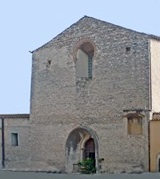
This was the site of the church (12th century) of Sant’ Andrea della Valle. The Augustines acquired it in 1266 at the instigation of Bishop Orlando (1261-1303), who was a member of the new Augustinian Order of Hermits.
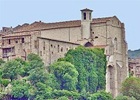
The church was remodelled early in the 18th century and re-consecrated in 1728.
Exterior
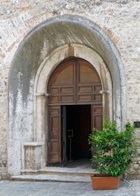
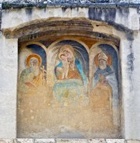
Interior
Frescoes (ca. 1400) in the Lower Apse
These frescoes were covered in plaster in the 18th century and only partly recovered in the restoration of 1991. The surviving scenes are obscured by the 18th century decoration.
A number of them are attributed to the Maestro della Dormitio di Terni:
-
✴Christ enthroned with angels, with the Virgin and SS Andrew on the left and SS John the Baptist and Augustine on the right. The Virgin is shown as the Madonna della Misericordia and the Madonna del Latte. Much of the figure of St Augustine has been lost.
-
✴The Assumption of the Virgin and (below) figures of SS Margaret of Antioch and Giles. Only the lower part of the Assumption, in which angels raise the Virgin in a mandorla, survives.
-
✴St Martin shares his cloak with a poor man and (below) a series of fragmentary heads of (from left to right): St Augustus, St Antony Abbot and two figures that both seem to be of St James. Little of this fresco of St Martin survives, except for the poor man’s feet and a magnificent horse’s head.
-
✴Fragments of the heads of (from left to right): the Madonna della Misericordia; St Jerome; and larger fragments of two saints (a deacon and an Apostle).
There are two interesting and broadly contemporary fragments by other artists:
-
✴the Madonna and child with St Antony Abbot (who commends a kneeling donor) and a deacon saint; and
-
✴St Ursula and companions.
Madonna and Child with saints (1482)
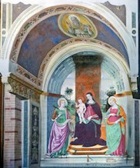
-
✴The main fresco depicts the Madonna and Child with SS Lucy (with her eyes on a plate) and Apollonia.
-
✴The fresco in the arch over the aedicule depicts God the Father.
The fresco was first attributed to Pier Matteo d' Amelia in 1933, and Federico Zeri included it in the proposed corpus of this artist that he assembled in 1953. This attribution received strong reinforcement in 1996, when a document was published that relates to a loan that Pier Matteo d’ Amelia negotiated in Narni in 1482.
Standing saints (15th century)
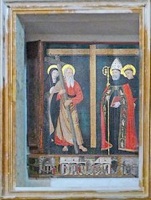
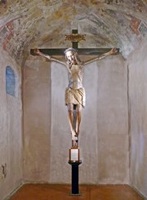
Panel in Sant’ Agostino Crucifix, now in San Giovenale
This panel, Which is in a niche on the right, near the counter-facade, is attributed to Pancrazio Jacovetti da Calvi. It depicts a large wooden cross with pairs of standing saints to either side:
-
✴SS Monica and Andrew (the original titular of the church), on the left; and
-
✴SS Augustine and Nicholas of Tolentino, on the right.
The panel apparently originally formed the backdrop for a Crucifix (15th century) that is now in San Giovenale, which is illustrated here. The arms of the figure of Christ are moveable, which suggests that it was removed from the cross and taken in procession during the Easter commemorations.
The cross and plain background of the panel were painted in at an unknown time over the original landscape setting.

The predella, which might be by another artist, depicts:
-
✴the martyrdom of St Andrew;
-
✴the flagellation and the road to Calvary in an architectural setting (illustrated above); and
-
✴the Mass of St Augustine.
Madonna della Cintola (date?)
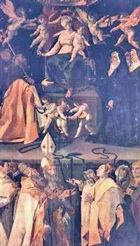
Cappella di San Sebastiano
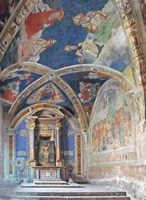
This chapel, which is immediately on the left as you enter the church, belonged to the Confraternita di San Sebastiano. In 1523, the confraternity commissioned its fresco decoration from Lorenzo and Bartolomeo Torresani. The contract records that these artist came from Verona and were, at that point, resident in Narni.
An inscription in the fresco in the 2nd bay on the right, which is written in a mixture of Umbrian and Venetian dialects, reads: “benché riccho di cor el Torresan Lorenzo veronese foi pur constreto per povertà lasar questa opera diserta onde ne ha dolar” (although rich in heart, Lorenzo Torresani of Verona was forced, through poverty, to leave this work unfinished, for which he feels great regret). This is usually assumed to have been written by Bartolomeo after Lorenzo had ceased for some reason to be associated with the project. There was also apparently a date, 1538, inscribed on a candelabra depicted on the left wall.
The frescoes conform closely to the programme specified in the contract. However, the frescoes, which were covered in plaster at some point, are in a very poor condition.
Altar Wall
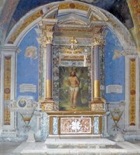
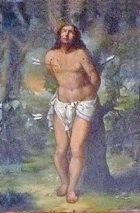
Frescoes on the Walls
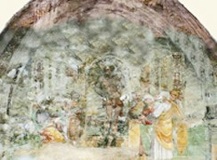
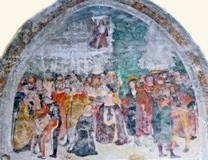
Martyrdom of St Sebastian Martyrdom of SS Zoe and Tranquillinus
Entrance wall 2nd bay on the right
The fresco in the 2nd bay on the left (i.e. the bay nearest the altar wall) was destroyed when a window was inserted. The other frescoes on the walls depict:
-
✴St Sebastian whipped in the Hippodrome, before the Emperor Diocletian (1st bay on the left);
-
✴the martyrdom of St Sebastian (on the entrance wall, illustrated on the left above);
-
✴St Sebastian enters the palace of the Emperor Diocletian (1st bay on the right); and
-
✴the martyrdom of SS Zoe and Tranquillinus, followers of St Sebastian (2nd bay on the right).
Frescoes in the Vaults
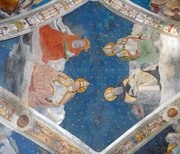
Doctors of the Church
The frescoes in the vaults are split into seven scenes, which depict:
-
✴the Redeemer (in the lunette above the altar wall);
-
✴the Doctors of the Church against a starry sky (in the middle of the chapel, illustrated above);
-
✴four frescoes to the sides of it, each of which depicts an Evangelist and a Prophet; and
-
✴SS Juvenal and Cassianus, in the lunette above the entrance.
Sacristy
Fresco fragment (ca. 1482)
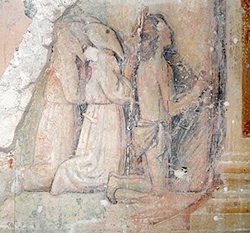
St Sebastian and penitents
Courtesy of Dottore Giuseppe Fortunati
This fragment of a fresco, which depicts St Sebastian and flagellants, is attributed to Pier Matteo d' Amelia, who (as noted above) was documented in Narni in 1482. The subject of this fragment suggests that the present sacristy was used in the late 15th century by the Confraternita di San Sebastiano, who presumably commissioned the work. It might have been in their chapel before they acquired the present Cappella di San Sebastiano (above).
Crucifixion (1500)
This fresco of the Crucifixion with the Virgin and SS Mary Magdalene and John the Evangelist is attributed to the Maestro della Tomba Cesi.
Art from the Church
Panels (1390)
Two documented panels depicting SS Fabian and Roch, which were signed "Cola de orto pinxit MCCCLXXXX" (Cola Petruccioli painted this in 1390), no longer survived in the church by the time that Giovanni Eroli described it in his “Descrizione delle Chiese di Narni e Suoi Dintorni” (1898).
Polyptych (1409)
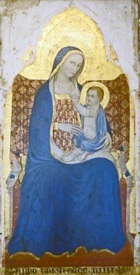
-
✴panels depicting SS Andrew, Catherine of Alexandria, John the Evangelist and Augustine in the Pinacoteca Vaticana, Rome; and
-
✴four predella panels depicting scenes from the life of St Augustine in the Alte Pinakothek, Munich.
All of these panels are illustrated in the website of the Fondazione Federico Zeri. Zeri also suggested that the polyptych was originally in Sant’ Agostino.
Read more:
S Felicetti, “Lorenzo e Bartolomeo Torresani, Pittori Veronesi nella Chiesa di Sant'Agostino di Narni (1523)”, Studi di Storia dell’ Arte, 8 (1997) 297-306
Return to Monuments of Narni.
Return to Walk I.

